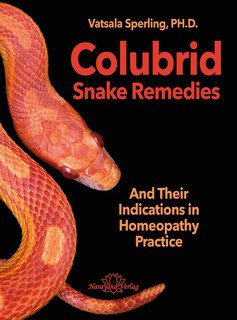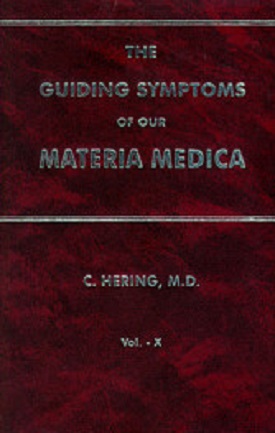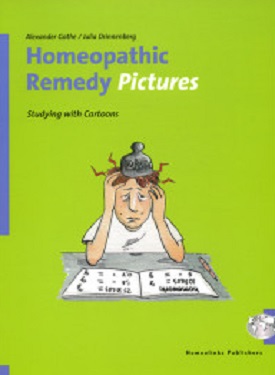Description
Please read the below book description as well as the below book review!
Dr. Vatsala Sperling is a brilliant homeopath who was originally trained as a clinical microbiologist. Her scientific training coupled with her deep experience as a homeopath has led her to write this important book.
Remedies from venomous snakes, Crotalus, Elaps, Lachesis, Naja, and Vipera sp., are well known and in use since late 1800s-early 1900s. Recent developments in homeopathy enable us to identify words and gestures used by people requiring remedies from these snakes, and prescriptions can also be based purely on symptoms and pathological indications.
However, some individuals express the language and gestures indicative of venomous snake remedies without presenting any hint of the ferocious energy and immense physical power of these snakes. Will remedies from venomous snakes still benefit them? Or do they need remedies made from nonvenomous snakes?
These questions led Dr. Vatsala Sperling to explore the nonvenomous snakes be¬longing to Colubridae family, understand their natural behavior and the winning strategies they use for survival and compare these with the natural behavior and survival strategies of venomous snakes. The author draws from her study of animal remedies and Colubrid snakes to show their unique expertise – mimicry. She ex¬plores the place of snakes in the periodic table of animals developed by Drs. B and S Joshi and shows how mimicking bigger, and venomous snakes help the Colubrids at¬tain self-protection. Six cases from her practice are used as examples. In these cases, repertorization points to venomous snakes. However, focusing on the words, energy and gestures used by clients in the clinical setting, instead of relying on rubrics, led her to differentiate between venomous and nonvenomous snakes, and choose rem¬edies from nonvenomous snakes. Five different species of nonvenomous Colubrid snakes, Cyclagras, Elaphe, Lampropeltis, Natrix and Thamnophis sp. are described in detail with regards to their general, maternal, predatory, and anti-predatory behavior. The outcome after taking the indicated nonvenomous snake remedies shows the effectiveness of the remedy choice.
Identifying and including nonvenomous snake remedies in your own practice could enable you to help a larger number of your clients who express themes, words, and gestures indicative of nonvenomous snake
Vatsala Sperling, PhD, CCH, RSHom
Dr. Vatsala Sperling, MS, PhD, PDHom, CCH, RSHom, is the former Chief of Clinical Microbiology services at The CHILD’s Trust, a children’s hospital in Chennai, India, where she conducted research with the World Health Organization (WHO) and published extensively. After moving to the United States, Dr. Sperling pursued an education in homeopathy at Misha Norland’s School of Homeopathy, Devon, UK. The author of ten books through Inner Traditions as well as many essays and articles on homeopathy, health, and spirituality, she continues to study and practice homeopathy in Vermont. She also volunteers for the National Center of Homeopathy and has served on the board of directors of the North American Society of Homeopaths.

The below book review was published at the website www.hpathy, an excellent online homeopathy magazine:
Colubrid Snake Remedies & Their Indications in Homeopathic Practice,
by Vatsala Sperling – 232 pp., 1st ed. 2023, ISBN: 978-3-96257-322-5, Narayana Verlag GmbH.
Review by Ashok RajGuru
Snakes evoke a mixed response. On the one hand, they have been revered in every culture since ancient times and on the other hand, they are also considered the most abominable creatures. But aside from their importance in rituals and worship, they have also been associated with the healing arts.
Homeopaths since early times introduced many well-known snake remedies, such as Lachesis, Crotalus, and others. The choice of these remedies was based primarily on poisoning records and provings. As we all know, provings can never elicit all the possible symptoms in all possible combinations of constitutions, age groups, and other variations in humans.
Therefore, in the last two decades, many new approaches have evolved to understanding remedies. One such approach is based on understanding a remedy based on its source. Animal kingdom remedies are associated with issues of survival and instinctual expressions. These include competition, domination, persecution, sexuality, and group behavior, as well as affection, care, and mischief.
The latest book by Dr. Vatsala Sperling is a groundbreaking study and analysis of the not-so-common snake remedies. The author spends a lot of time in the rainforests of super-rural Costa Rica, home to some of the most feared and dreaded snakes.
What she learned from the natives was that there are several snake species that look scary, but are not venomous. On the contrary, they keep the rodent population down without posing a threat to humans. Such snakes, unlike the dangerous venomous ones, thrive near human habitations. Surely one could venture to consider these snakes as sources of remedies too. This set her on the quest to understand and benefit from these non-venomous snakes.
Dr. Vatsala is a scientist by training and received a gold medal from the President of India for academic excellence. Before moving to the US, she was the Chief of Clinical Microbiological Services at India’s largest children’s hospital.
She was initiated into the healing arts by her mother who taught her the elements of Ayurveda. Later she took up the study of Homeopathy and qualified as a professional practitioner of homeopathy from the United Kingdom. Presently, she runs a successful holistic practice in the United States. In addition to this, she is fluent in several Indian languages including Sanskrit. Her rich and diverse background spanning across science and spirituality gives her an exceptionally unique perspective.
Dr. Vatsala takes inspiration from the pioneering work of Drs. Bhawisha and Shachindra Joshi in adapting narrative medicine for the study of remedy sources. Narrative medicine is about honoring the stories of illnesses of patients.
By placing events in the lives of patients on a timeline, and by noting the metaphorical expressions and gestures of patients it is possible to connect the dots and point to a remedy using the principle of simillimum. This approach has far-reaching consequences. Instead of just limiting oneself to the physical, mental, and emotional expression of symptoms, one can map the behavior and energy of the patient with a specific animal.
This book first summarizes the general characteristics, predatory and anti-predatory behavior, and venom effects of snakes. Further, for readers who are unfamiliar with the periodic table/maps of animals, this book provides a sufficiently comprehensive summary to get a clear understanding.
This book is about snake remedies derived from the Colubridae family. This family includes king snakes, water snakes, milk snakes, garter snakes, racers, rat snakes, and many others. The Colubridae family has nearly 1,866 members, and this book explores five of them.
The peculiarity of this family is that they mimic venomous snakes. Mimicry can occur in form, color, appearance, or even acoustics (hissing). This gives these snakes an evolutionary advantage, because by mimicking the dangerous snakes they deter predators by deceit and do not have to invest in the venom apparatus. Such mimicry is not limited to snakes and is found in butterflies, ants, and spiders too. As we all know, sometimes, even bank robbers steal money with toy guns!
Dr. Vatsala outlines in detail the mimicry as well as the anti-predator behavior of the subfamilies of Colubridae. This helps the reader develop a thorough understanding and build a solid foundation in the application of newer approaches such as Kingdoms, Sensations, and the Periodic Table and Maps.
The author explains how the Colubridae family finds its place in Row 4 of the periodic table or Map of the animal kingdom which deals with self-protection. Interestingly, we humans are dominated by the characteristics of Row 3 (development of ego) and Row 4 (self-protection).
It is important to note that only two contemporary authors, Sankaran and Vermeulen have written about the Colubridae family. These authors have only presented the biology, habitat, and reproductive behavior, and homeopathic cases of Colubridae snakes are conspicuously absent. This book fills this important gap.
The examples in the book have been selected with care – they illustrate remedy selection based on the periodic table of animal maps. In each case study, the author walks you through actual human actions, gestures, words, and behavior and pairs them with corresponding snake characteristics.
Each case study is more than just analyzing the sum of the symptoms – it guides the reader on how to be a keen listener and stay an unbiased observer. This leads to discovering how patients, through their expression, lead you to the appropriate remedy.
Each case is summarized in a tabular form listing the prominent animal themes, the snake themes, and the corresponding Colubridae themes. The principal expression themes and symptoms are gathered and matched with suitable rubrics from the Complete Repertory.
Thereafter, analysis results are filtered for the animal kingdom. Colubridae remedies are under-represented in our materia medica and repertories and thus, these remedies may either not show up at all or may have a very low score. What does one do in such a situation? I will not put a spoiler in my review by revealing the secret and I would encourage you to read the book to work around this roadblock!
There are six case studies that cover five Colubridae remedies. The selection of these remedies is based purely on matching human expressions to the behavior of these snakes. There is no reference to any Homeopathic Pathogenetic Trials (HPT) or drug provings.
In other words, drug choice is based purely on a speculative premise of mapping. The results obtained by the use of these drugs are shown as very effective, but it is felt that the reader would have liked to know how they compared with findings confirmed by HPTs. For example, in February 2011 Peter Fisher collated provings of Natrix Natrix. The author could have compared and confirmed her findings with published provings.
In Case 1 the author concludes by stating that the patient “has received other remedies too, depending on his symptoms and the chief area of discomfort/disturbance, and usually these do not run him down as they did before Natrix”. It would have helped if the author had shared the details of case management and the remedies utilized over the 9-month-long timeline. This would have helped understand remedy relationships such as collateral, complementary, inimical, or antidotal actions.
The book is truly the seminal work of a dedicated researcher. It will serve as an excellent resource not only to students and practitioners of homeopathy but also to those practicing narrative medicine and doing research in the fields of Batesian mimicry, evolutionary studies, and ophiology.
It is very well written, and the production quality is excellent. Dr. Vatsala shows how she has symbiotically integrated the newer trends of sensation, narrative medicine, periodic table, and the effective use of gestures and words.
While the quality of the editing is excellent, the reviewer has one suggestion. There are many sentences with a word count ranging from 45 to 75 words. Such long sentences reduce readability. It has been found that when the average sentence length is 14 words, readers understand more than 90% of what they are reading. At 43 words, comprehension drops to less than 10%. Long sentences force users to slow down and work harder to understand what they are reading.
The book has excellent high-resolution photographs of the snakes referred to in the book, but it would have helped the reader if pictures of the Colubridae were shown alongside the species they mimic.
In conclusion, I would say that this book deserves to be on the bookshelf of every serious homeopath.






Reviews
There are no reviews yet.